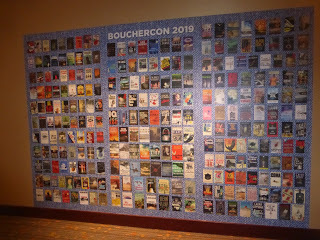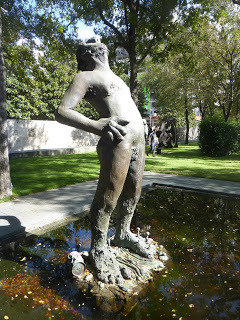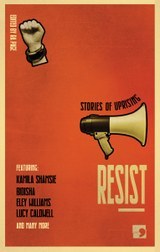Martin Edwards's Blog, page 101
November 13, 2019
The Looking Glass War - 1970 movie review
I became a John Le Carre fan in my early teens, devouring his first three books with a great deal of enthusiasm. Then I read The Looking Glass War, and simply didn't "get" it. With hindsight, that was probably due, at least in large measure, to my tender years. Le Carre has said that he aimed to write a satire about spying, but I think it's fair to say that it's a long way short of his best work. I thought about giving it another go, and then the film version, made in 1970, turned up on Talking Pictures TV so I decided to take a look at it.
The film has a strong and varied cast, although today, perhaps the most interesting thing about it is that the young son of Avery (Anthony Hopkins) is played by Russell Lewis, who is now renowned as the creator and sole writer of the excellent Endeavour and has written many other crime scripts for television.
The story begins with the murder in Finland of a British spy (Timothy West). Back home, a motley crew of secret service men, including Hopkins and Sir Ralph Richardson, persuade Leiser, a good-looking young Polish man (an oddly cast American actor, Christopher Jones) to undertake a mission at considerable risk to himself. So far, so good. Unfortunately, at this point Frank Pierson's screenplay begins to drag. And it continues to drag, apart from one or two interesting moments, right to the end. By that time, I really didn't care about the outcome. It's not nearly as good as another Le Carre film, The Deadly Affair, which I reviewed recently, far less the superb and much more recent TV series The Night Manager.
So the cast - including such stars as Susan George, Ray McAnally, Maxine Audley, and Anna Massey, as well as Pia Degermark (whose later life has apparently seen as much unhappiness as did the unfortunate Jones') - is largely wasted. The soundtrack by Wally Stott is a kind of poundshop Bacharach effort that simply isn't strong enough; Wally Stott (who later became Angela Morley) was talented, but he was neither Bacharach nor John Barry. Given Le Carre's fame and brilliance, I wonder if there is scope for a remake of this film. Perhaps. But if there is, it will need a much sharper script.
The film has a strong and varied cast, although today, perhaps the most interesting thing about it is that the young son of Avery (Anthony Hopkins) is played by Russell Lewis, who is now renowned as the creator and sole writer of the excellent Endeavour and has written many other crime scripts for television.
The story begins with the murder in Finland of a British spy (Timothy West). Back home, a motley crew of secret service men, including Hopkins and Sir Ralph Richardson, persuade Leiser, a good-looking young Polish man (an oddly cast American actor, Christopher Jones) to undertake a mission at considerable risk to himself. So far, so good. Unfortunately, at this point Frank Pierson's screenplay begins to drag. And it continues to drag, apart from one or two interesting moments, right to the end. By that time, I really didn't care about the outcome. It's not nearly as good as another Le Carre film, The Deadly Affair, which I reviewed recently, far less the superb and much more recent TV series The Night Manager.
So the cast - including such stars as Susan George, Ray McAnally, Maxine Audley, and Anna Massey, as well as Pia Degermark (whose later life has apparently seen as much unhappiness as did the unfortunate Jones') - is largely wasted. The soundtrack by Wally Stott is a kind of poundshop Bacharach effort that simply isn't strong enough; Wally Stott (who later became Angela Morley) was talented, but he was neither Bacharach nor John Barry. Given Le Carre's fame and brilliance, I wonder if there is scope for a remake of this film. Perhaps. But if there is, it will need a much sharper script.
Published on November 13, 2019 04:00
November 9, 2019
Arizona, Texas, and the 50th Bouchercon


I got back to England on Tuesday after an eventful (in more senses than one) trip to the United States. And after a few days catching up on much-needed sleep and a mountain of emails, I'm reflecting on a hectic but utterly engrossing experience, demanding in some ways but made thoroughly enjoyable thanks to the kindness and generosity of some wonderful American folk.
I'd planned to attend Bouchercon in Dallas for some time, in the hope of promoting Gallows Court, which was recently published in the US. The trip became more elaborate when my US publishers, Poisoned Pen, invited me to do a couple of evening events at the Poisoned Pen bookstore in Scottsdale. So I managed to change my flights and plans and set off happily. Alas, the trip involved a connection at Heathrow where the news was broken to me that my suitcase had gone AWOL. That rather ruined the flight to Phoenix, though I did get to watch a thriller film, Get Out (begins very well, turns into horror hokum) and the entertaining Elton John biopic Rocketman. The latter was interrupted several times by announcements from American Airlines about how wonderful they are, not a message for which I was in the mood. On the way back, I watched the rather lower-key Tolkien, which was very well done if a bit thinner in terms of story than the author's own work.
Having failed to trace my suitcase on landing, I hot-footed it to Scottsdale, where I had dinner in the hotel with Barbara Peters, editor at PPP and a great supporter of my work for a very long time. She's got a saying that I've become an overnight success after only 30 years, and she treated me to dinner and sympathy about my missing belongings, offering me very welcome practical support. Then it was off to the store to do an event with Donis Casey, an author I've never met before, who proved to be most charming. The following morning was devoted to a fruitless suitcase hunt before I went to meet more members of the PPP staff for an informal lunch. I started to do some clothes shopping but before I'd spent a fortune I returned to the hotel for a rest - and the suitcase had suddenly turned up. I was very relieved, to say the least, and it put me in good heart for the rest of the trip.
That evening's event was fascinating - a chance to share a platform with a writer I've long admired, Nicholas Meyer. He made his name with The Seven-Per-Cent Solution, a Sherlock Holmes novel, and when it was filmed, he was nominated for an Oscar for the screenplay. Since then he's written and directed two Star Trek films and three more Sherlock books, the latest of which has just been published. It was a real pleasure to talk to him and I really enjoyed a convivial dinner with Nicholas and our respective editors after our last books had been signed in the store. A memorable occasion.

Then it was off to Dallas for the 50th Bouchercon. I arrived late, but registered on Friday morning and took part in a panel on collecting detective fiction moderated by Otto Penzler, also moderating a panel about setting in crime fiction with five authors I'd not met before, who proved to be excellent panellists. In between, there was a chance to catch up with a host of good friends including Steve Steinbeck, Manjiri Prabhu, Les Klinger, Deborah Crombie, Bruce Coffin, Joni Langevoort, and Shelly Dickson Carr (though such is the mad whirl of Bouchercon that I managed to miss several people altogether) and making some new acquaintances, including Francis M. Nevins, whose bio of Cornell Woolrich I much admire. I spent quite a bit of time hanging around the bookroom in a fruitless quest to track down Marvin Lachman, whose wonderful The Heirs of Anthony Boucher has just appeared in a revised and expanded edition. However, I restricted my purchases to a mere two slim volumes (and even then, my suitcase was overweight when I flew home - perhaps illustrating why relying on carry-on baggage doesn't really work for me).

Poisoned Pen Press ran two great events, one for authors and one for readers (where we authors offered them clues in a mystery contest), both of which were a lot of fun. It's good to see the popularity in the US of the British Library Crime Classics. Over the weekend, I was commissioned to write a short story for a prestigious anthology, and I've already started working on that. And there was time to have dinner hosted by the talented and likeable Edwin Hill on one night and then with pals from Malice Domestic including Verena Rose and Shawn Reilly Simmons on another. There were surprisingly few British authors present, but it was good to chat with Peter Lovesey and Felix Francis (both of whom were guests of honour), Caro Ramsay and Helen Smith.



I felt it would be crazy to go all that way and not do any sight-seeing, and so I spent much of Sunday wandering around the city (and going up the Reunion Tower), while on Monday morning I ventured out for a stroll along the "grassy knoll" which has been the subject of so much speculation in connection with JFK's assassination. Quite an experience. All in all, an unforgettable trip.






Published on November 09, 2019 04:30
November 7, 2019
Forgotten Book - The Far Cry
Fredric Brown was not only a first-rate crime writer, he was also remarkably versatile. In fact, I suppose you could argue that most of the best crime writers had the flexibility of approach and imagination to write a wide range of types of story. That was certainly true of Brown, who mastered both the short story and the novel, and wrote private eye fiction as well as stunning stand-alones. I'm surprised his work is not better known. He really was a wonderful entertainer.
The Far Cry, published in 1951, is one of his finest novels. It benefits from a vividly evoked setting, the town of Taos in New Mexico, where Brown had recently made his home, with his second wife. It seems to me that there are strong autobiographical echoes in the novel, and the protagonist, George Weaver, is someone who seems in some respects to have a touch of Brown about him.
Weaver is a real estate agent from Kansas City who is getting over a breakdown. He moves to Taos to recuperate, and rents a house in which, eight years earlier, a murder occurred. A young woman called Jenny Ames was killed by a man called Nelson, who met her through a Lonely Hearts club, but Nelson was never brought to justice. George becomes obsessed by the case, and tries to solve the mystery of the crime and find Nelson. Meanwhile, he is joined in Taos by his wife Vi, but their marriage is on the rocks, and he now finds her repellent.
Brown was very good at atmospherics, and he conjures up people and place with rare skill. Weaver is on a downward spiral, motivated only by an obsession with Jenny reminiscent of Mark McPherson's obsession with the eponymous Laura in Vera Caspary's novel - although the two books are very different. The final twist struck me as clever but debatable - to say why would be a spoiler. But this is a very good book and I'd be glad to discuss it with anyone else who has read it.
The Far Cry, published in 1951, is one of his finest novels. It benefits from a vividly evoked setting, the town of Taos in New Mexico, where Brown had recently made his home, with his second wife. It seems to me that there are strong autobiographical echoes in the novel, and the protagonist, George Weaver, is someone who seems in some respects to have a touch of Brown about him.
Weaver is a real estate agent from Kansas City who is getting over a breakdown. He moves to Taos to recuperate, and rents a house in which, eight years earlier, a murder occurred. A young woman called Jenny Ames was killed by a man called Nelson, who met her through a Lonely Hearts club, but Nelson was never brought to justice. George becomes obsessed by the case, and tries to solve the mystery of the crime and find Nelson. Meanwhile, he is joined in Taos by his wife Vi, but their marriage is on the rocks, and he now finds her repellent.
Brown was very good at atmospherics, and he conjures up people and place with rare skill. Weaver is on a downward spiral, motivated only by an obsession with Jenny reminiscent of Mark McPherson's obsession with the eponymous Laura in Vera Caspary's novel - although the two books are very different. The final twist struck me as clever but debatable - to say why would be a spoiler. But this is a very good book and I'd be glad to discuss it with anyone else who has read it.
Published on November 07, 2019 16:30
November 4, 2019
Doublecross - 1956 film review
[image error]
While researching my British Library anthology Deep Waters, I consulted a number of classic crime enthusiasts in the hope of broadening the scope of my selections. Jamie Sturgeon came up with a copy of "The Queer Fish" by Kem Bennett, an author and story completely unfamiliar to me. I shared Jamie's liking for it, and the story duly appeared in my collection earlier this year.
Kem Bennett may be pretty much forgotten as a writer now, but in his day he wrote occasionally for film and TV as well as producing a handful of novels, not all of them criminous. And he was involved in writing the script for a film based on "The Queer Fish". This was Doublecross, which was released in 1956, a year after the story appeared in a magazine.
Thanks to Talking Pictures TV, I've recently watched the film version. It's a typical British B-movie of its era, short, quite likeable, and crammed with actors who became familiar to me as I grew up in the 60s and 70s. These include William Hartnell, later the first Doctor Who, and the versatile Allan Cuthbertson, who was a good comic actor as well as adept at playing posh chaps in straight roles.
Cuthbertson and Anton Diffring play a couple of spies who are on the run, along with Diffring's wife, after committing a murder. They flee to Cornwall - and the Cornish locations in the film are a pleasing bonus. I'm not sure which little fishing village formed the backdrop - might it have been Mevagissey, a place I've yet to visit? - but it's certainly nice to look at. The baddies hire Donald Houston, a local poacher, to take them in a stolen boat to France and freedom. But as the title implies, the trip does not go smoothly... Not a bad time-passer, though perhaps unsurprisingly I prefer the story.
Published on November 04, 2019 04:59
November 1, 2019
Forgotten Book - Skin for Skin
Skin for Skin by Winifred Duke was published by Gollancz in 1935, and it earned a rave review from another Gollancz author, no less an authority than Dorothy L. Sayers. Duke was an expert in true crime who also wrote fiction, and this novel is based very, very closely on the Wallace case. The names have been changed - Wallace becomes Bruce, Liverpool becomes Salchester, and so on - but Duke didn't deny that she was fictionalising very recent events. Wallace was convicted of murdering his wife in 1931, but the conviction was quashed on appeal. He did not, however, enjoy his freedom for long.
In this story, it is made clear from the outset that Bruce deliberately set about planning to murder his wife. Duke was at pains to emphasise that she was not suggesting that this meant she thought Wallace guilty (and thus "lucky to get away with it"), although it's hard to believe she'd have written this book in this way if she believed he was innocent. Her argument, in effect, was that she was trying to imagine what would have motivated him if he had indeed been guilty. This argument does raise ethical questions, although I think it's a legitimate piece of work. Indeed, as the title (taken from the Book of Job) suggests, this is a book with a moral.
The writing is plain, but very readable, and I raced through the story. Even though I'm very familiar with the Wallace case, I found myself gripped by Bruce's story. I have some reservations about the book, but I can see why Sayers admired it. It's a very lucid piece of work. Faction, you might call it.
My greatest reservations concern not Duke's writing, but her fictional premise. I struggle to believe that Wallace was guilty. This is a case which I've had the pleasure of discussing with two considerable authorities, P.D. James (who thought he was guilty, though previously she'd thought him innocent) and Roger Wilkes (who wrote an important book seeking to establish his innocence). Sayers also wrote about the case in detail, and I share her view that Wallace's psychological profile was not that of a murderer. Duke does a good job, in creative fiction terms, of trying to explain his motivation, on the premise that he did decide to kill his wife. But even though I enjoyed reading the book, and can recommend it, I'm still not convinced. I think Wallace was a wretchedly unlucky man, who suffered a terrible injustice.
In this story, it is made clear from the outset that Bruce deliberately set about planning to murder his wife. Duke was at pains to emphasise that she was not suggesting that this meant she thought Wallace guilty (and thus "lucky to get away with it"), although it's hard to believe she'd have written this book in this way if she believed he was innocent. Her argument, in effect, was that she was trying to imagine what would have motivated him if he had indeed been guilty. This argument does raise ethical questions, although I think it's a legitimate piece of work. Indeed, as the title (taken from the Book of Job) suggests, this is a book with a moral.
The writing is plain, but very readable, and I raced through the story. Even though I'm very familiar with the Wallace case, I found myself gripped by Bruce's story. I have some reservations about the book, but I can see why Sayers admired it. It's a very lucid piece of work. Faction, you might call it.
My greatest reservations concern not Duke's writing, but her fictional premise. I struggle to believe that Wallace was guilty. This is a case which I've had the pleasure of discussing with two considerable authorities, P.D. James (who thought he was guilty, though previously she'd thought him innocent) and Roger Wilkes (who wrote an important book seeking to establish his innocence). Sayers also wrote about the case in detail, and I share her view that Wallace's psychological profile was not that of a murderer. Duke does a good job, in creative fiction terms, of trying to explain his motivation, on the premise that he did decide to kill his wife. But even though I enjoyed reading the book, and can recommend it, I'm still not convinced. I think Wallace was a wretchedly unlucky man, who suffered a terrible injustice.
Published on November 01, 2019 16:18
October 30, 2019
The Deadly Affair - 1966 film review
I read John Le Carre's novel Call for the Dead a very long time ago, but I've only just caught up with the film made of it by Sidney Lumet, a director of distinction. It was retitled The Deadly Affair and stars James Mason as Charles Dobbs - the same character as George Smiley in the novel, but renamed for legal reasons as the naming rights were tied up by someone else. (I always tend to think, by the way, that a mutually sensible approach to negotiation could resolve these oddities, but alas, people don't always negotiate sensibly...)
The cast is excellent, starting with the ever-reliable Mason, who really was a good actor. Harry Andrews is a highly believable retired cop, while Simone Signoret, in a less than glamorous role, is terrific. So is Harriet Andersson as Anne, Mason's wife, who loves him but torments him with her affairs. Roy Kinnear, Kenneth Haigh, and Lynn and Corin Redgrave also make telling appearances. The script is by Paul Dehn, who had worked on Goldfinger and later teamed up with Lumet again on Murder on the Orient Express. The soundtrack is by Quincy Jones, and there's a decent title song, "Who Needs Forever" by Astrud Gilberto; the music isn't quite in the John Barry class, but it's still high-calibre 60s easy listening.
With so much talent involved, the film is very watchable, even if the story seems slightly stretched out and a bit predictable. The legendary Freddie Young was responsible for the cinematography and he gives the movie a distinctly dark look, with several very well-chosen London locations. It's quite a modern-seeming look, even if the Hyde Park restaurant in which one scene was shot was demolished about thirty years ago. The visual style of the film coupled with the performances contribute to a downbeat mood which works well, even if it lacks the pace and melodrama of, say, the James Bond movies. It wasn't a box office hit, and I can see why, but it's stood the test of time pretty well.
The premise is simple. After a tip-off, Dobbs interviews an agent who may be a spy. The agent promptly commits suicide - but did he really kill himself, or were dark forces at work? The answer to that question is easily guessed, but Lumet and his collaborators still kept me engaged from start to finish.
The cast is excellent, starting with the ever-reliable Mason, who really was a good actor. Harry Andrews is a highly believable retired cop, while Simone Signoret, in a less than glamorous role, is terrific. So is Harriet Andersson as Anne, Mason's wife, who loves him but torments him with her affairs. Roy Kinnear, Kenneth Haigh, and Lynn and Corin Redgrave also make telling appearances. The script is by Paul Dehn, who had worked on Goldfinger and later teamed up with Lumet again on Murder on the Orient Express. The soundtrack is by Quincy Jones, and there's a decent title song, "Who Needs Forever" by Astrud Gilberto; the music isn't quite in the John Barry class, but it's still high-calibre 60s easy listening.
With so much talent involved, the film is very watchable, even if the story seems slightly stretched out and a bit predictable. The legendary Freddie Young was responsible for the cinematography and he gives the movie a distinctly dark look, with several very well-chosen London locations. It's quite a modern-seeming look, even if the Hyde Park restaurant in which one scene was shot was demolished about thirty years ago. The visual style of the film coupled with the performances contribute to a downbeat mood which works well, even if it lacks the pace and melodrama of, say, the James Bond movies. It wasn't a box office hit, and I can see why, but it's stood the test of time pretty well.
The premise is simple. After a tip-off, Dobbs interviews an agent who may be a spy. The agent promptly commits suicide - but did he really kill himself, or were dark forces at work? The answer to that question is easily guessed, but Lumet and his collaborators still kept me engaged from start to finish.
Published on October 30, 2019 05:54
October 28, 2019
"The Cap of Liberty"

My latest short story, "The Cap of Liberty", has just been published, and it's safe to say that it's a bit different. For a start, it's accompanied by an academic essay written by Professor Robert Poole and exploring the factual background to the story. And it's appearing in an anthology just published by Comma Press, and edited by Ra Page, called Resist. The sub-title is: Stories of Uprising. I was commissioned to write a work of fiction connected to the Peterloo Massacre, which occurred two hundred years ago last August.
Those who know me may well think that I'm an unlikely contributor to an anthology of fiction about protest, a book with subjects ranging from the distant past (Boudica's Rising) to the recent present (Grenfell). The fact is that I'm seldom seen on marches or waving banners, far less glueing myself to anything (except by accident) but I was pleased to be asked to take part. I've had a connection with Comma Press for a long time now, getting on for fifteen years, and they are an admirable independent outfit, based in Manchester, and dedicated to producing high quality books at the cutting edge of contemporary literature. They are (I quote from their very interesting website) a not-for-profit initiative dedicated to promoting new writing, with an emphasis on the short story, and committed to a spirit of risk-taking and challenging publishing, free of the commercial pressures on mainstream houses, and they aim "to put the short story at the heart of contemporary narrative culture". Words to savour. I've always regarded these aims not just as worthy but truly admirable.
A long time ago I had a short story published in a Comma publication of Liverpudlian fiction edited by Tane Vayu, and this led to a couple of CWA anthologies which I edited for them: I.D.: Crimes of Identity and M.O.:Crimes of Practice . Suffice to say that contributors included Mick Herron and Sarah Hillary, then relatively unknown and now superstars of the crime genre. More recently I contributed an essay about Sherlock Holmes short stories to Morphologies, another very interesting Comma Press book.
For those interested in how a story of this kind gets written, let me quote from Ra Page's original brief: "I would love to see what a no-holds-barred crime/detective story dealing with a historical protest might look like. Especially a protest like Peterloo. Of course, you might want to set the bulk of the story in the aftermath of the event (or even much later down the line), and then reveal aspects of the massacre through the backstories. That's up to you. I realise there weren't detectives or even police officers in 1819; it was all magistrates and soldiers, agent provocateurs and debt-bonded 'spies'. But I'd be super-excited to see what you did with it.
Anyway, you can take any approach: exactly how the protest intersects with your story is up to you. You can set your story slap bang in the middle of Peterloo, or you can have Peterloo in the recent (or even distant) background, as long as it was eventually revealed (or some aspect of it) by the story."
I thought long and hard about whether to accept this invitation, partly because I do have quite a lot of projects going on at present, and partly because I knew it would require a good deal of work, not only in terms of practical research but also thinking myself into the right mindset for the story. But I love Ra's enthusiasm and commitment, and so I said yes. He'd arranged for me to talk to Robert Poole, an expert on Peterloo, and I found our conversations and his writings on the subject very helpful. I decided to set my story in the 1830s, so that it became a sort of "cold case" narrative. Once I'd figured out a way in to the material - always so important when one tries something different - I went on a research trip to find out more about my chosen protagonist (a person from real life who has, in fact, appeared once before in my fiction).
The result was "The Cap of Liberty". It is in essence a story about both justice and injustice, which are key themes of so many crime stories and pretty much all of my own fiction. I'm glad that it's now seen the light of day and I hope the book will be a big success for Comma.
Published on October 28, 2019 05:00
October 25, 2019
Forgotten Book - A Case in Nullity
Evelyn Berckman is a writer whom I've only started to read in the past year or so. She was an American who moved to London after earlier having a career as a pianist and composer; she only embarked on a new career as a crime writer in the mid-Fifties, when she herself was in her mid-fifties. Her fiction was quite diverse, and she also wrote books about naval history. It may be that her failure to focus on a memorable series character has contributed to her neglect in recent years, but she could write very well.
A Case in Nullity is an example of the way she takes an interesting scenario, of the kind that you might find in many a novel of psychological suspense, and turns it into a novel of character, where development and revelation of character is at least as important as development of the plot. Actually, I'm not sure whether she was really very interested in plot, but even if (like me) you are, don't allow that to discourage you from looking at her work.
This is, on the surface, a variation on a classic woman-in-jeopardy theme. Auriol makes an unsatisfactory marriage, and when she seeks an annulment, because her husband refuses to have sex with her, he embarks on a malevolent campaign of persecution. The suspense builds well, as Auriol's situation becomes increasingly desperate.
Yet it becomes clear in the closing pages that Berckman's real interest is in the effect of the events of the story on her people. This book was first published in 1967, the year that homosexual acts were decriminalised in Britain, and attitudes towards (and on the part of) gay and lesbian people are central to Berckman's concerns. It must have seemed very "cutting edge" when it was written. Today, some of the attitudes portrayed seem questionable and dated, but even so, I found this an intriguing and unusual story.
A Case in Nullity is an example of the way she takes an interesting scenario, of the kind that you might find in many a novel of psychological suspense, and turns it into a novel of character, where development and revelation of character is at least as important as development of the plot. Actually, I'm not sure whether she was really very interested in plot, but even if (like me) you are, don't allow that to discourage you from looking at her work.
This is, on the surface, a variation on a classic woman-in-jeopardy theme. Auriol makes an unsatisfactory marriage, and when she seeks an annulment, because her husband refuses to have sex with her, he embarks on a malevolent campaign of persecution. The suspense builds well, as Auriol's situation becomes increasingly desperate.
Yet it becomes clear in the closing pages that Berckman's real interest is in the effect of the events of the story on her people. This book was first published in 1967, the year that homosexual acts were decriminalised in Britain, and attitudes towards (and on the part of) gay and lesbian people are central to Berckman's concerns. It must have seemed very "cutting edge" when it was written. Today, some of the attitudes portrayed seem questionable and dated, but even so, I found this an intriguing and unusual story.
Published on October 25, 2019 10:47
October 23, 2019
The Seven Deaths of Evelyn Hardcastle by Stuart Turton
There's something admirable about crime writers who take risks with their work, who try to do something different. Agatha Christie did this plenty of times, and so did Dorothy L. Sayers. And there are various examples among modern day writers. Of course, sometimes the risks don't pay off. Experiments can fail. Innovative books are often flawed - think of Dorothy L. Sayers and Robert Eustace's The Documents in the Case, a book sometimes criticised as drab, yet genuinely ground-breaking and in my opinion under-rated. Another example would be Freeman Wills Crofts' Antidote to Venom, a detective story with a moral message at its heart.
When I heard about Stuart Turton's bestselling debut, The Seven Deaths of Evelyn Hardcastle, I was at once keen to read it. In a note at the end of the paperback edition, he talks about discovering Agatha Christie at the age of eight and wanting to emulate her. So although I've never met him, I certainly have a fellow feeling for him. The energy and invention of his book seem to me to be absolutely admirable.
I want to be careful about what I say about this novel, so as to avoid spoilers, but it's widely known that it's an homage to the Golden Age with a difference - the luckless protagonist finds himself trapped in a number of different bodies as he tries to discover the truth about Evelyn Hardcastle's fate (which in turn entails discovering the truth about a crime 19 years earlier), and to see if he can change the course of history. In the classic manner, the setting is a country house, called Blackheath. There's a homicidal footman, a mysterious Plague Doctor, and much else besides.
This is a witty book, and although it calls for a huge amount of suspension of disbelief, the pace and drive of the first hundred pages or so ensure that Turton achieves a key goal - most readers, I'm sure, will be willing to buy into the premise. It's a complicated story, and a long one. In the latter stages, I felt that the author was probably trying a bit too hard to add on extra layers of meaning and complexity. There are also some turns of phrase that don't really fit in with a Golden Age story, and which I felt an editor should have picked up. I'm not convinced that the explanation of what is really going on at Blackheath stands up to much scrutiny, and for me, the motivation of the ultimate culprit was inadequately foreshadowed, thus weakening the power of that particular revelation. So the final part of the book didn't work as well for me as the very gripping early pages. No matter. Stuart Turton has written a novel which plays with Golden Age tropes in an absorbing and unusual way, and the result is something strikingly original. Quite something for a debut novel! I'll be fascinated to see what he comes up with next.
When I heard about Stuart Turton's bestselling debut, The Seven Deaths of Evelyn Hardcastle, I was at once keen to read it. In a note at the end of the paperback edition, he talks about discovering Agatha Christie at the age of eight and wanting to emulate her. So although I've never met him, I certainly have a fellow feeling for him. The energy and invention of his book seem to me to be absolutely admirable.
I want to be careful about what I say about this novel, so as to avoid spoilers, but it's widely known that it's an homage to the Golden Age with a difference - the luckless protagonist finds himself trapped in a number of different bodies as he tries to discover the truth about Evelyn Hardcastle's fate (which in turn entails discovering the truth about a crime 19 years earlier), and to see if he can change the course of history. In the classic manner, the setting is a country house, called Blackheath. There's a homicidal footman, a mysterious Plague Doctor, and much else besides.
This is a witty book, and although it calls for a huge amount of suspension of disbelief, the pace and drive of the first hundred pages or so ensure that Turton achieves a key goal - most readers, I'm sure, will be willing to buy into the premise. It's a complicated story, and a long one. In the latter stages, I felt that the author was probably trying a bit too hard to add on extra layers of meaning and complexity. There are also some turns of phrase that don't really fit in with a Golden Age story, and which I felt an editor should have picked up. I'm not convinced that the explanation of what is really going on at Blackheath stands up to much scrutiny, and for me, the motivation of the ultimate culprit was inadequately foreshadowed, thus weakening the power of that particular revelation. So the final part of the book didn't work as well for me as the very gripping early pages. No matter. Stuart Turton has written a novel which plays with Golden Age tropes in an absorbing and unusual way, and the result is something strikingly original. Quite something for a debut novel! I'll be fascinated to see what he comes up with next.
Published on October 23, 2019 07:40
October 21, 2019
Announcing 'Howdunit'

Front page news on The Bookseller on Friday was the announcement of a deal to publish an exciting new book written by members of the Detection Club. Howdunit, which I've compiled and edited, is about the art and craft of crime writing and it will be published by HarperCollins in June next year.
The contributors will include almost all the current members of the Detection Club, including Ian Rankin, Val McDermid, Ann Cleeves, Mick Herron, James Runcie, Peter James, Sophie Hannah, Peter Robinson, Felix Francis, Elly Griffiths, Peter Lovesey, Mark Billingham, and Len Deighton, to whom the book is dedicated - given that this year, Len celebrates 50 years as an enthusiastic member of the Club. They will offer a marvellous range of insights into the writing life, including personal reminiscences, practical tips for aspiring writers, and an insight into the realities of being a writer - there are terrific pieces, for instance, about "imposter syndrome" and "improvisation techniques" as well as thoughts on social media, writing for radio, and the experience of having your work adapted for TV and film.
And that's not all. The book will also include shorter pieces by a number of illustrious Detection Club members of the past, from G.K. Chesterton onwards. So readers will have a chance to compare the approaches of luminaries of the Golden Age, for instance, with those of their present day successors. It will, I think, be quite a book. I've been working hard on it for much of this year - since Club members decided at our AGM in February that they wanted to put together a book to raise funds for the Club.
And that's another remarkable and highly gratifying feature of this book - the lovely people who are contributing to it are donating all the proceeds to Club funds, to ensure that as it celebrates its 90th anniversary next year, it continues to thrive for the foreseeable future. I'm enormously grateful to each and every one of them for their wholehearted support, as well as for the wonderful pieces they are contributing.
More about this book before long. But in the meantime, there's still work to be done...
Published on October 21, 2019 02:11



